From the beginning of 2020 until now, the DeFi space could be summarised in two words: food fight. Indeed, it truly feels like a new ridiculous food-themed DeFi protocol is being added to this culinary carnage every other day. One of the most sought-after DeFi delicacies? Sushi, of course!
For most crypto enthusiasts, the introduction of SushiSwap signaled that DeFi had officially gone too far. In fact, the controversial events surrounding the project, which unfolded in the short weeks after its release, spoiled the appetite of many in the DeFi space.
However, there is much more than meets the eye (or the tongue in this case!) when it comes to SushiSwap. The initial 2,500%+ APYs on deposited funds were just the tip of the tilapia. In September 2020, the SUSHI token was successfully listed on Binance, and control over the project was transferred from the original, anonymous founders to disgraced FTX ex-CEO Sam Bankman-Fried. Since then, SushiSwap has rolled out various features on the protocol, truly promising to become ‘the’ Michelin star Defi Hub.
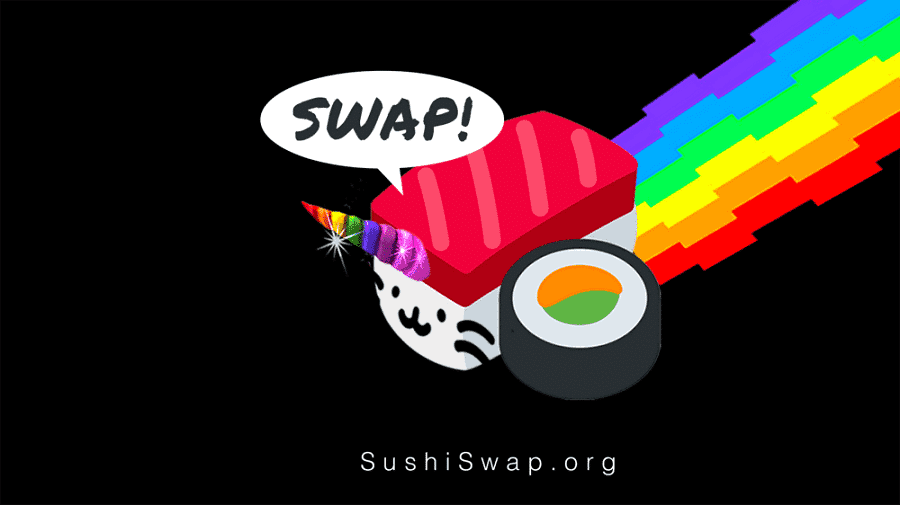
In late 2020, SushiSwap was the largest DeFi protocol on the market. According to DeFi Pulse, SushiSwap currently stands in 11th position for Total Value Locked (TVL) in DeFi, with $1.51 billion in assets on its platform.
This is a clear fall from the last time we covered SushiSwap on the Coin Bureau website in August 2021. At that time, SushiSwap held the 8th position for Total Value Locked (TVL) in DeFi, with almost $4 billion in assets on its platform. However, in 8 months, the DEX has fallen nearly 62% in TVL, while the TVL of the entire Defi Market has remained almost unchanged since then.
This raises the question of what has changed for SushiSwap since then. Therefore, by the end of this article, you will better understand what SushiSwap is, where it is headed, and if it can climb back up the rankings again.
Who Founded SushiSwap?
SushiSwap was founded by two anonymous developers named 0xMaki and Chef Nomi. On August 26 2020, Chef Nomi released a Medium post detailing the SushiSwap protocol. This enticed 0xMaki to join the SushiSwap Discord.
Being one of the first participants, 0xMaki spoke at length with Chef Nomi and consequently became the co-founder of SushiSwap. It is believed that around five developers were working on the project at the time of release.

While not much is known about 0xMaki or Chef Nomi, in an interview from 2020 with the Unchained Podcast, 0xMaki confirmed that Chef Nomi is based somewhere in Asia. Furthermore, the fact that the Hearthstone card game, from which the Chef Nomi pseudonym originates, is popular in China suggests Chef Nomi could be Chinese.
Given 0xMaki’s French accent, appearance, and time-zone hint, he is likely based somewhere in France or a French-speaking Middle Eastern country. 0x is in reference to the starting number and letter of all Ethereum addresses, and Maki is a popular sushi dish.
SushiSwap’s Fishy History
In addition to being created by two anonymous developers, SushiSwap was not audited before release. That being said, Chef Nomi openly invited some of the most reputable companies, including Quanstamp and Consensys, to audit SushiSwap’s code in the first Medium post about the project.
Within the first week of its release, SushiSwap had accumulated over 1 billion USD in locked funds and temporarily surpassed Aave as the largest DeFi protocol. Interest rates on locked funds exceeded 2,500% APY!
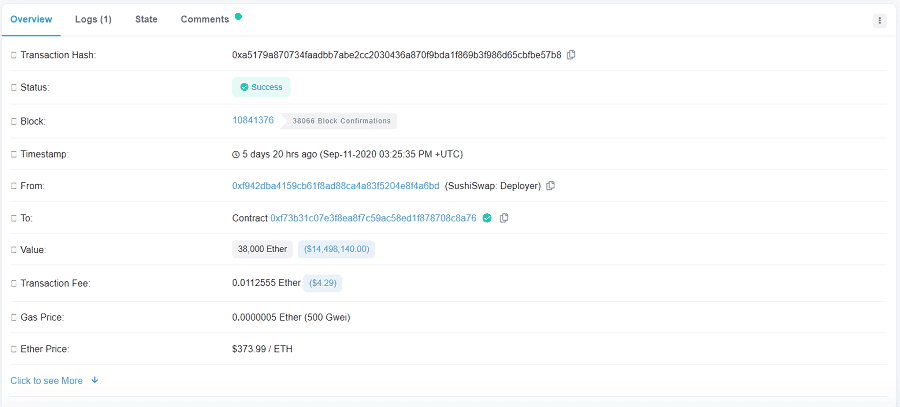
On September 5th 2020, Chef Nomi suddenly liquidated over 14 million USD of SUSHI tokens accumulated as development funds by the protocol. In a series of Twitter posts, he noted he felt entitled to the funds. This drew immense outrage from the cryptocurrency community, most notably yearn.finance creator Andre Cronje.
Popular YouTuber Ivan on Tech also remarked that “[SushiSwap] is just as bad as real sushi”. Ivan also noted that the sudden sell-off of SUSHI likely caused a crash in the cryptocurrency market the next day due to its effect on the entire DeFi Space.
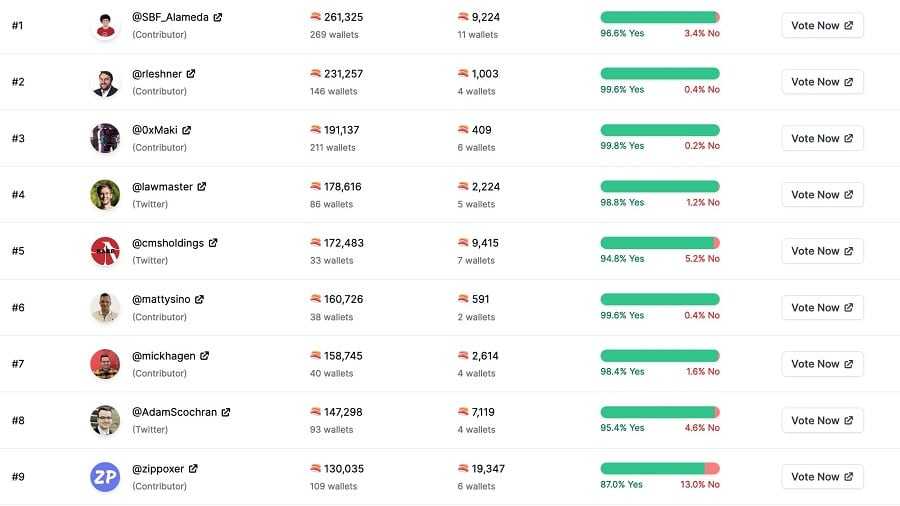
Chef Nomi subsequently stepped away from Sushiswap and handed it to Sam Bankman-Fried. The SushiSwap developers had also considered Andre Cronje as the new de facto leader of the protocol.
The SushiSwap community voted to select nine individuals in the DeFi space, such as Compound Finance’s founder Robert Leshner to be keyholders for the multi-sig wallet holding SushiSwap’s development funds.
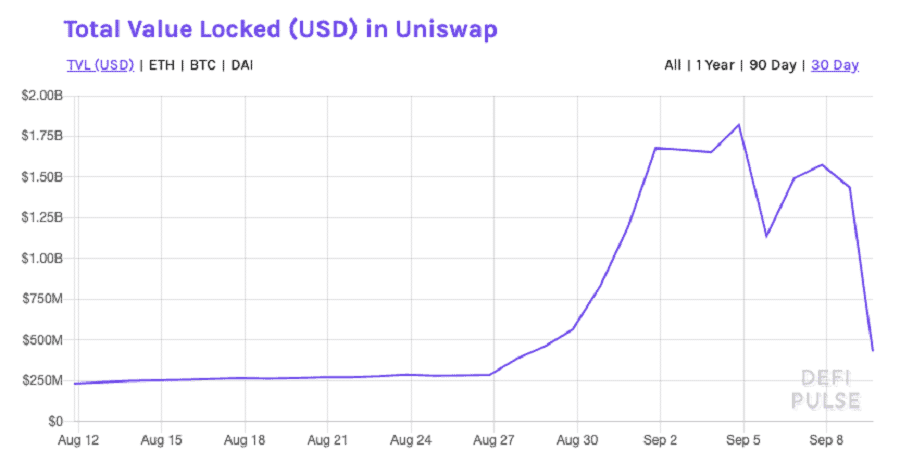
On September 9th 2020, Uniswap was stripped of its title as the largest decentralized exchange when SushiSwap users migrated over 1.14 billion USD of Uniswap’s 1.9 billion USD locked cryptocurrency assets to the new SushiSwap platform.
Though this migration had been planned since the protocol’s announcement, 0xMaki believed that no more than a few hundred million dollars of cryptocurrency would be moved. This sudden liquidity transfer from one protocol to another has been dubbed a vampire attack.
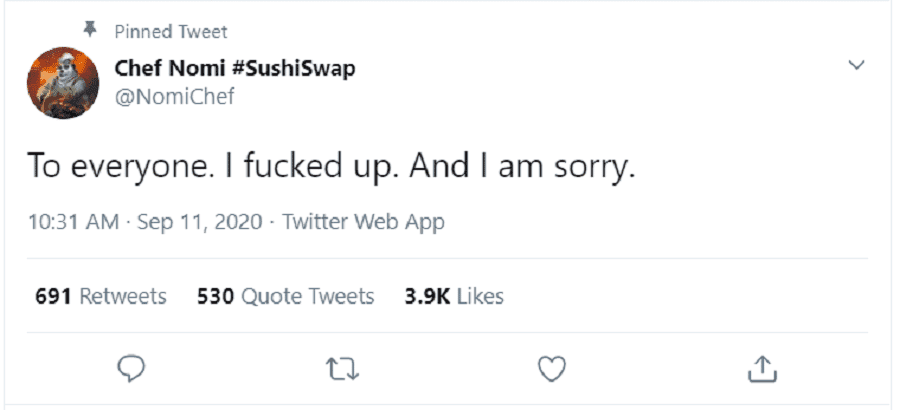
On September 11th 2020, Chef Nomi suddenly returned the stolen development funds to SushiSwap. Some believe this was done to draw more attention to the project. However, in the interview mentioned above with 0xMaki, he noted that he had issued an ultimatum over Twitter to Chef Nomi, telling him to answer his messages or else he would reveal sensitive details about SushiSwap (likely Chef Nomi’s true identity).
Chef Nomi is no longer involved with the protocol and now describes himself on Twitter as the “former head chef” at SushiSwap.
What is SushiSwap?
SushiSwap is a decentralized cryptocurrency exchange (DEX) built on the Ethereum blockchain. It aims to be an evolution of Uniswap, the most popular Ethereum-based DEX on the cryptocurrency market. It is almost identical to Uniswap in both appearance and function.
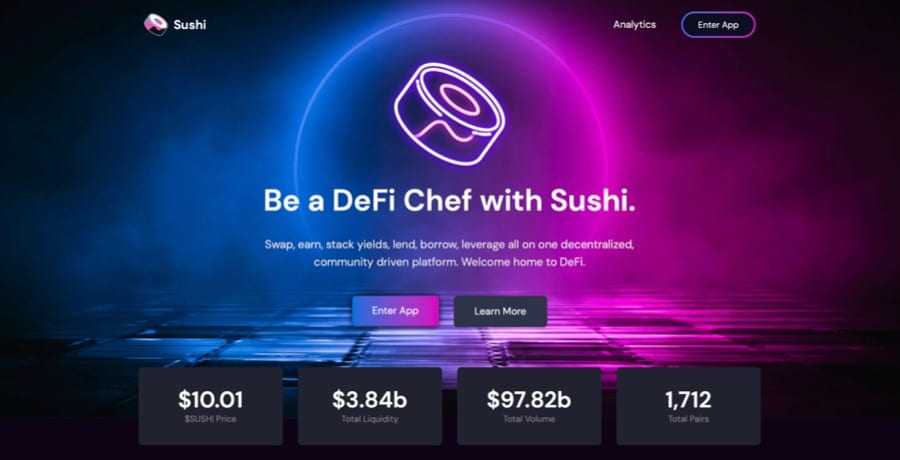
SushiSwap rewards those who deposit cryptocurrency to provide liquidity to the protocol with SUSHI, an ERC-20 token given to liquidity providers on SushiSwap, which can be used to govern the protocol.
Although SushiSwap has a controversial history, it was and continues to be heavily community-driven and committed to the open-source ethos of cryptocurrency. All smart contracts and code are easily accessible by anyone via SushiSwap’s GitHub and Medium posts.
SushiSwap has also been audited by PeckShield and reviewed by Quantstamp. SushiSwap borrows much of its code from other popular DeFi protocols, including Uniswap, Compound Finance, and the infamous Yam Finance.
DEX vs AMM
Before we begin looking at SushiSwap in-depth, let us first clear up what some of the abbreviated terms we come across in this article mean!
DEX- ‘DEX’ stands for ‘Decentralised Exchange’. A DEX is a platform that allows its users to trade tokens without an intermediary (e.g. centralized exchange). Typically, a DEX does not have custody over the user’s assets. Instead, the tokens are traded directly between peers through smart contracts on the platform. Users also need not verify themselves through KYC, nor do they have to deal with the CEXs restrictions like withdrawal limits. There are two main types of DEXs: Order book based and Liquidity pool based.
AMM- ‘AMM’ stands for ‘Automated Market Maker’. DEXs like SushiSwap and Uniswap use an AMM to facilitate the exchange of tokens on their platform. Most AMMs are smart contracts that use something called ‘Constant Product Market Maker’- a mathematical function that algorithmically determines the price of an asset based on the ratio of assets within the liquidity pool.
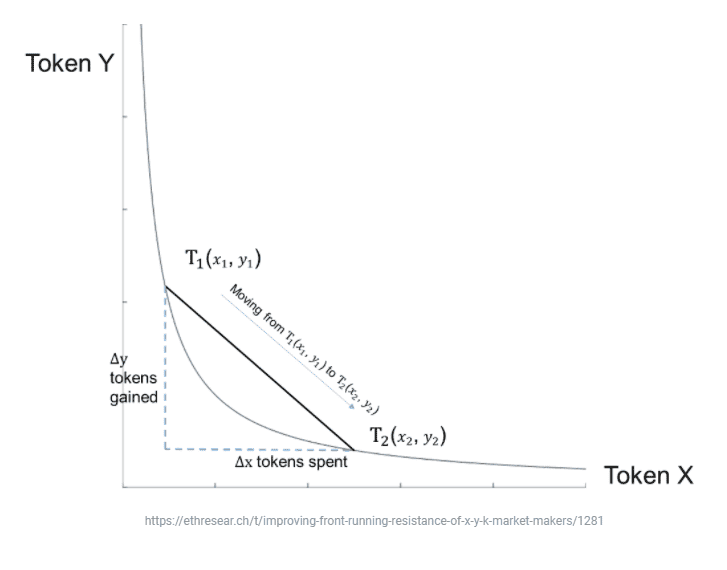
The function is represented as x*y=k, where ‘x’ and ‘y’ refer to the quantity of the two assets in the liquidity pool and ‘k’ is the product of ‘x’ multiplied with ‘y’. The idea behind the function is that ‘k’ must always remain constant. To achieve that, when the supply of x increases, the supply of y must proportionally decrease and vice versa.
If you were to graph an automated market maker equation, you would see something known as a ‘bonding curve’. It shows that the more of an asset in a pool is purchased relative to the others, the more expensive it becomes, increasing exponentially up to a theoretically infinite price.
This makes it practically impossible for anyone to buy all of the cryptocurrency in the pool and gives arbitrage traders more incentive to come in and restore balance when the ratio between the pooled assets (and, therefore, price) deviates too much.
SushiSwap vs. Uniswap
With SushiSwap being a Uniswap fork, both DeFi protocols consequently share architectural and aesthetic similarities. However, three key differences should be noted here:
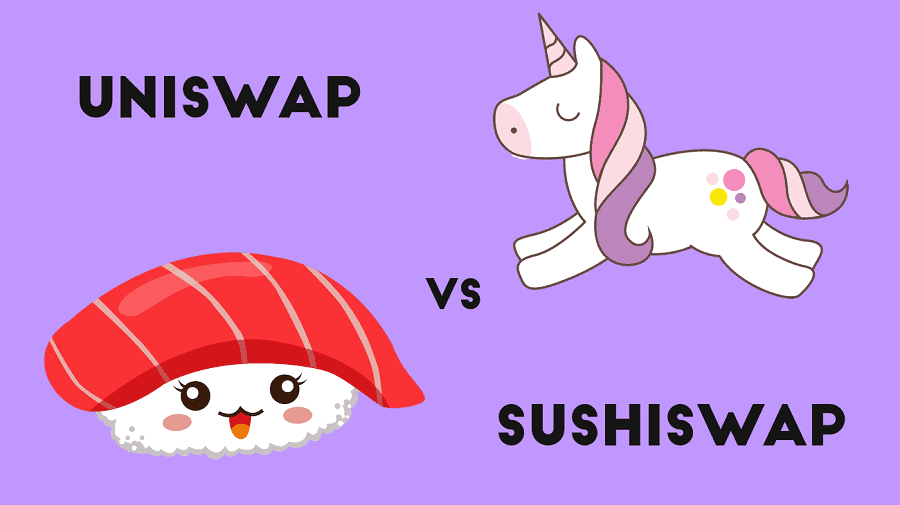
Liquidity Provision Rewards: The first is an issue present in Uniswap that SushiSwap does not have. Liquidity providers (LPs) earn a cut of the trading fees on both protocols. In Uniswap, the more liquidity someone provides, the larger the cut of the trading fees from the pool they will get. The consequence is that rewards to smaller liquidity providers become diluted as the pools grow. Large entities such as cryptocurrency exchanges, mining pools, and venture capital funds can and often do get the lion’s share of these trading fees.
Conversely, SushiSwap designed its SUSHI emission so that early adopters of the protocol would receive 10x the amount of SUSHI as those who join the protocol later. This SUSHI could be used to get a cut of trading fees from all pools even if the early adopters stopped providing liquidity to pools (via the Sushi Bar - more on this later).
Multi-chain DEX: The second key difference is the number of networks that the DEXs operate on. While Uniswap is only present on the Ethereum, Polygon, Optimism and Arbitrum Network, SushiSwap is a truly Multichain Automated Market Maker that is present on over 16 blockchain networks such as Ethereum, Polygon, BSC, Harmony, Fantom, etc. to name a few.
Features: The third key difference is the number of features offered on the DEXs. Uniswap has traditionally only offered the AMM and liquidity pool farming feature. SushiSwap, on the other hand, has made it a point to be a pioneer in expanding the services that a DEX can provide. Some of the additional key features that SushiSwap provides are Kashi (Lending & Leverage), Sushi Bar (Staking), BentoBox (Token Vault), and MISO (IDO Launchpad).
PROS and CONS
Now that we’ve compared SushiSwap with Uniswap let us look at the pros and cons of the platform.

Pros:
- SushiSwap is a multi-chain DEX present on more than 16 blockchain networks
- SushiSwap offers its users more features (exchange, lending, launchpad, token vault, etc) than most other DEXs in the market
- Follows a profit sharing model- Staked Sushi (xSUSHI) holders receive a portion (0.05%) of the trading fees charged by the platform.
- No KYC or mandatory identity verification
Cons:
- No cross-chain swap feature yet
- Shady Past- History of drama and security concerns
- Dwindling TVL and market share
- The share of trading fees allotted for liquidity providers is lower for SushiSwap (0.25%) than Uniswap (0.30%)
How Does SushiSwap Work?
Like many other DEXs, SushiSwap fundamentally consists of several asset pools. Each pool contains two assets, such as ETH and LINK (Chainlink). This is because it uses an Automated Market Maker (AMM). This smart contract uses the ratio between two assets in each pool to determine their price. Additionally, SushiSwap also has a limit order market that users can use to trade assets stored in BentoBox.
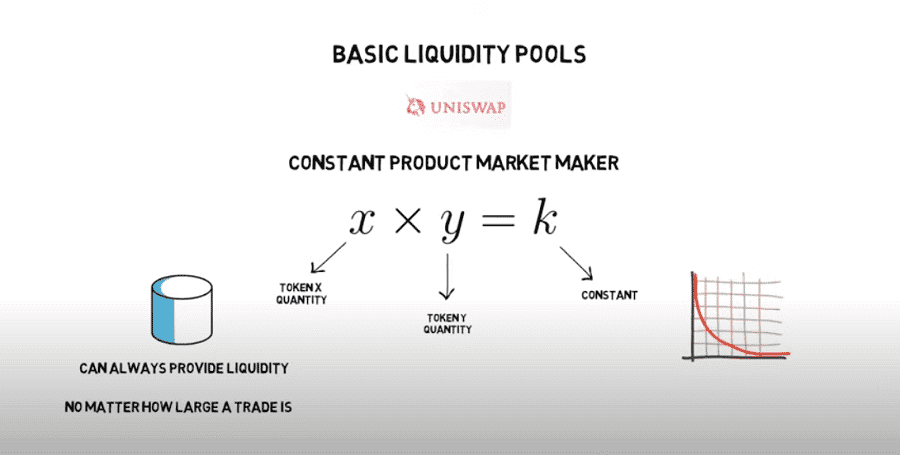
When SushiSwap was initially released, it focused around Uniswap LP (liquidity provider) tokens. LP tokens on Uniswap are ERC-20 tokens issued to liquidity providers when they deposit assets into pools on Uniswap.
These tokens can be exchanged for the underlying deposited funds, used in other DeFi protocols, and even exchanged for other LP tokens. Liquidity providers also receive a share of the trading fees of the assets in the pools they provide liquidity for via the LP tokens.

What SushiSwap did was to reward liquidity providers on Uniswap for staking their Uniswap LP tokens on the SushiSwap protocol. Their reward? SUSHI tokens! During the first two weeks of the protocol’s launch, 1000 SUSHI tokens were issued every Ethereum block (~12 seconds) to users who staked their Uniswap LP tokens into a variety of comedically named “pools”.
Given the high market valuation of SUSHI at the time, interest exceeded 2,500% APY per year in many of these pools. The highest returns were (and continue to be) from the Sushi Party pool, which gave an additional 2x reward in SUSHI for staking Uniswap LP tokens for the SUSHI-ETH pairing.
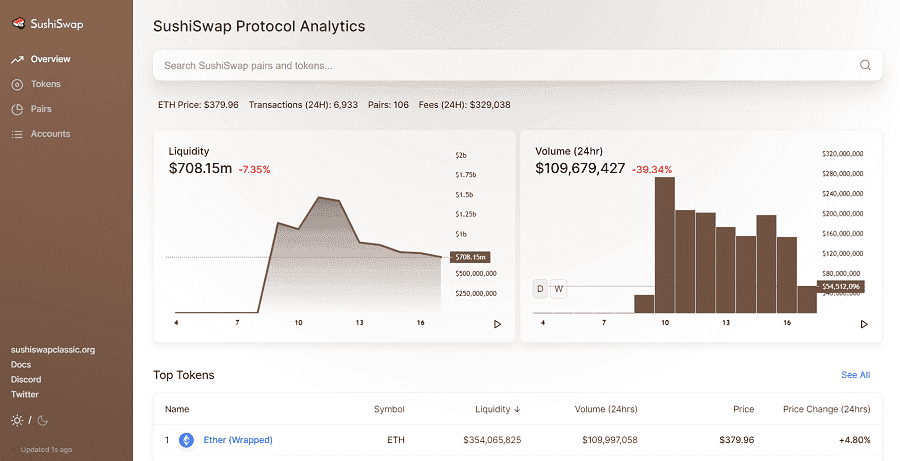
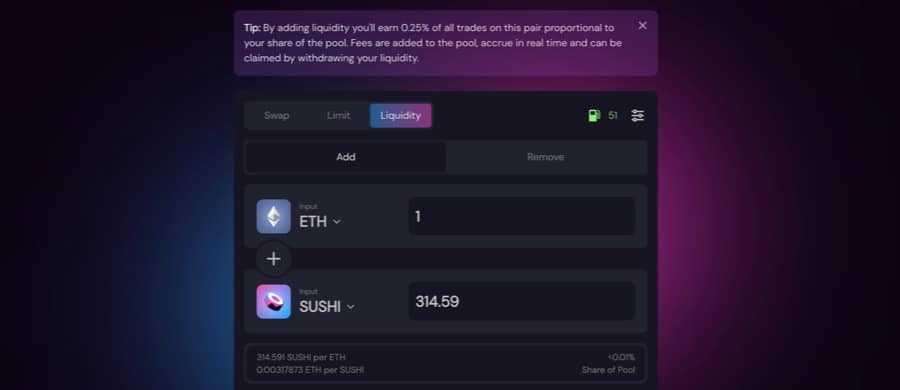
At the end of the two weeks, 'The Liquidity Migration' occurred. This saw all the Uniswap LP tokens automatically sent back to Uniswap to redeem them for the underlying crypto and send it all to SushiSwap's new pools. This event drained over 1.14 billion USD from Uniswap within 24 hours.
After this, SushiSwap effectively became a carbon copy of Uniswap with additional features. SUSHI rewards were also reduced to 100 SUSHI per block. SushiSwap as it is currently built consists of the following menu of applications: the SushiSwap Exchange (Swap & Limit Order), SushiSwap Liquidity Pools (Pool), SushiSwap Farming (Farm), BentoBox (Token Vault), Kashi (Lending & Leverage), Sushi Bar (Staking) and Minimal Initial SushiSwap Offering (MISO).
In terms of governance, SushiSwap is ultimately run and governed by its community through forum discussions, and voting proposals held on the SushiSwap Snapshot. For example, all major infrastructural changes and use of the development fund wallet are voted on by the SushiSwap community. In contrast, more minor changes affecting operations and farming pairs are decided on by 0xMaki and the SushiSwap Core Team.
SushiSwap Exchange
The SushiSwap Exchange lets you easily swap between 100+ ERC-20 tokens. As with Uniswap, no KYC is required to use the SushiSwap exchange. All you need is a Web 3.0 wallet such as Metamask and some Ethereum to pay gas fees to execute swaps.
The SushiSwap Exchange offers its users two primary exchange options- Instant Swapping via Liquidity Pools and the Limit Order V2 feature.
Swapping via Liquidity Pools
The swap feature on the AMM utilises the liquidity present in Liquidity Pools to allow users of the platform to deposit one token and withdraw the other instantly.
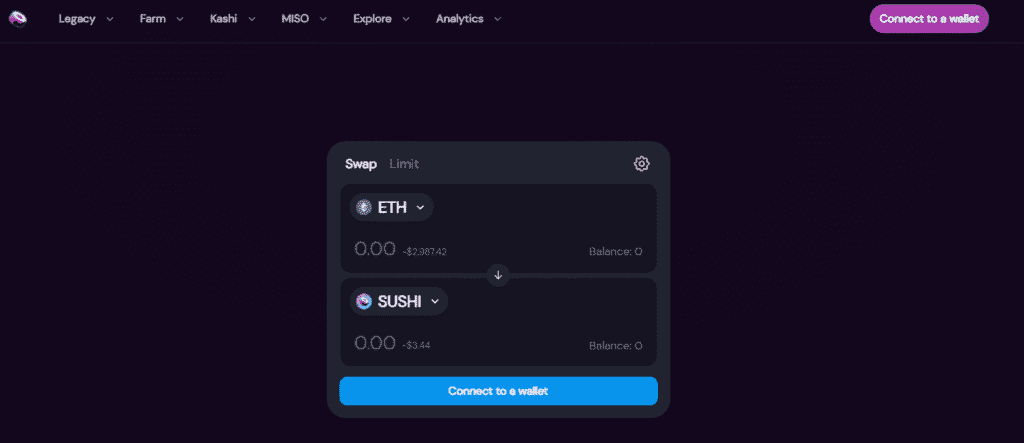
The protocol charges a 0.3% trading fee on the total value of the asset being swapped. 0.25% of these fees go to those providing liquidity in SushiSwap’s Liquidity Pools, and the remaining 0.05% goes to the Sushi Bar pool (more on that in a second).
Sushiswap Limit Order V2
In contrast to order book-driven exchanges, AMMs typically only settle orders at market price, which is a significant constraint. With the debut of the limit order feature, SushiSwap tackles a significant AMM pain point.
A limit order is a request to buy or sell an asset at a predetermined price. As distinct from a market order, which executes immediately after an order is placed, a limit order will not execute unless the asset reaches the price set by the user.
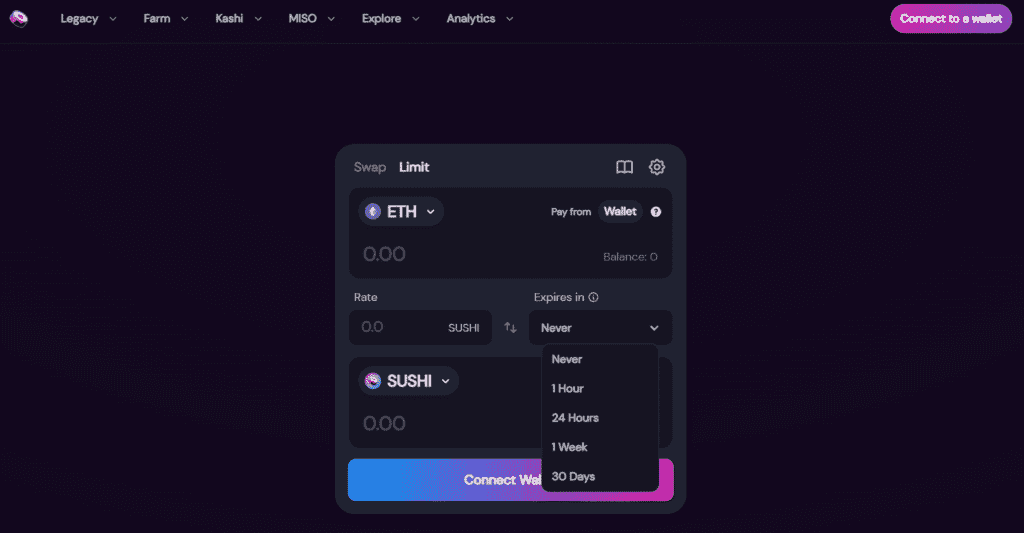
Limit Orders on SushiSwap are far more capital efficient than regular limit orders placed on CEXs. Unlike a CEX, which blocks the relevant funds when a user places a limit order, SushiSwap allows users to set many different limit orders for many different tokens, all using the same underlying capital.
Limit Orders on SushiSwap do not use a traditional order-matching mechanism to match orders between peers. Instead, it leverages the underlying AMM mechanism of the DEX to instantly execute a swap in the liquidity pool when the target price has been hit. In addition, when you create a limit order, the capital used is stored in the BentoBox, so these funds are also eligible for added yield.
SushiSwap’s Onsen Menu (Farm)
SushiSwap’s Onsen Menu is a liquidity provision reward system for relatively new tokens. Tokens selected to be on the Onsen “menu” are allocated SUSHI tokens per block to incentivize liquidity provision. The benefit to being on the Onsen menu is that the projects themselves aren’t forced to incentivize their communities to provide liquidity for their tokens because Sushi does it for them.

Liquidity providers are given SushiSwap Liquidity Pool tokens (SLP tokens) which have the same features as Uniswap's LP tokens. These tokens can then be staked on the farm to receive yield in SUSHI tokens. And besides pure SUSHI token farming, SushiSwap offers a wide array of farming opportunities to its users, including a great variety of asset pairs with different risk levels and APYs.
Users looking to farm on SushiSwap should:
- Head over to Sushi.com.
- Click 'Enter App'.
- Connect Metamask Wallet.
- Click 'Farm'.
At this stage, farmers will be able to see all the available farms on the SushiSwap platform through the 'All Farms', 'Kashi Farms', 'Your Farms' and 'SushiSwap Farms' Tabs.
Once the preferred Farm is selected, users will subsequently need to click 'Stake' to initiate the farming process, or 'Unstake', to withdraw funds.
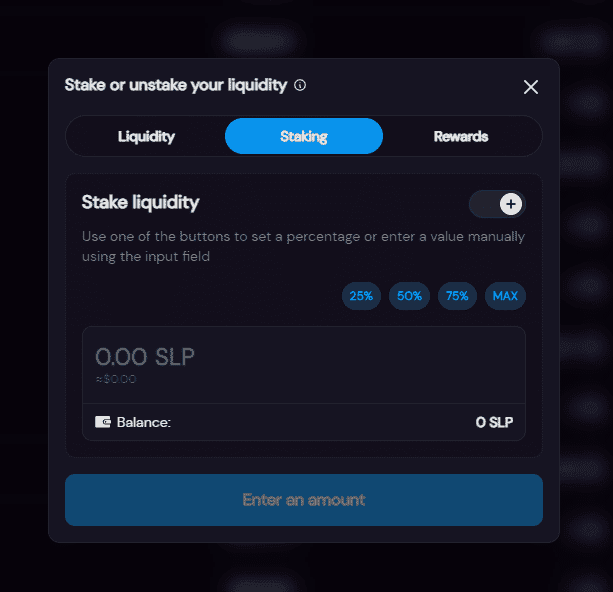
After entering the desired amount and clicking on ‘Stake’, users can then preview their selected asset pair for the respective farm and confirm the transaction on Metamask. ETH will be required to settle the transaction. Depending on the asset pair and farm, APYs can vary drastically from approximately 7% to more than 600%, which is, of course, representative of the risk exposure undertaken by farmers at any one time.
SushiSwap SUSHI Bar (Stake)
SushiSwap’s Sushi Bar is where you can stake SUSHI tokens to earn more SUSHI tokens. If you wonder where these rewards come from, recall the 0.05% trading fee noted earlier. 0.05% of all trading fees on SushiSwap are added to the Sushi Bar pool in the form of SLP tokens.
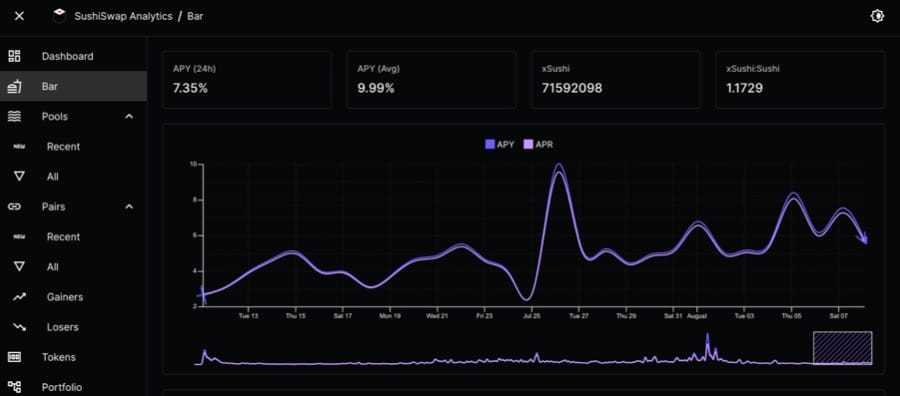
At least once every 24 hours, the rewards contract can be called, which automatically liquidates all SLP tokens in the Sushi Bar pool to buy SUSHI tokens on the SushiSwap Exchange. These tokens are then distributed to all users staking SUSHI tokens in the Sushi Bar in the form of xSUSHI tokens, which can be converted into regular SUSHI tokens in the Sushi Bar.
SushiSwap BentoBox (Token Vault)
A Bento Box is a Japanese lunchbox filled with an assortment of dishes that a person can enjoy during their meal. Similarly, SushiSwap’s BentoBox is a token vault that users can use to deposit an assortment of different tokens or funds. By doing so, users receive extra yield on deposits through flash lending, strategies, and fixed, low-gas transfers among integrated dapps, like Kashi markets.
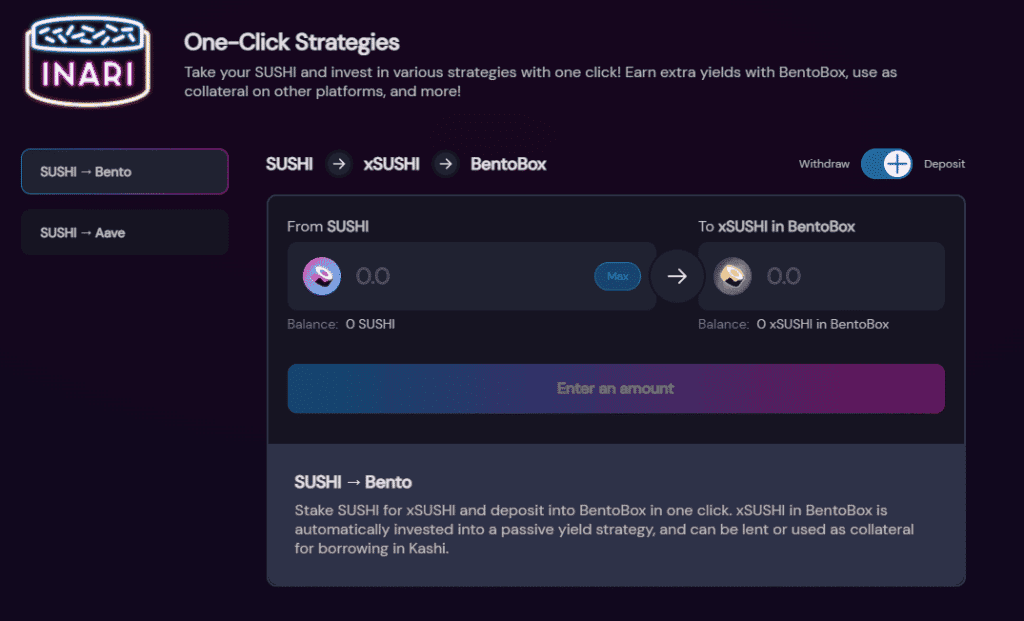
The idea behind the BentoBox is to create a native foundational layer in the form of a vault upon which future financial products built on SushiSwap can be leveraged.
BentoBox’s innovation lies in its ability to track the user’s deposits via artificial balance, which is used to account for their idle funds, while the same funds are simultaneously applied to strategies. In a way, it is similar to the fractional reserve system.
BentoBox is designed to be scalable and serves as the future infrastructure for upcoming DeFi protocols on SushiSwap, the first of which is Kashi.
SushiSwap Kashi (Lending & Leverage)
In Japanese, the word ‘Kashi’ comes from the verb ‘Kasu’, which means ‘to lend’. Similarly, SushiSwap’s Kashi is also a lending and margin trading platform built on BentoBox, allowing anyone to create customized and gas-efficient markets for lending, borrowing, and collateralizing various DeFi tokens, stable coins, and synthetic assets.
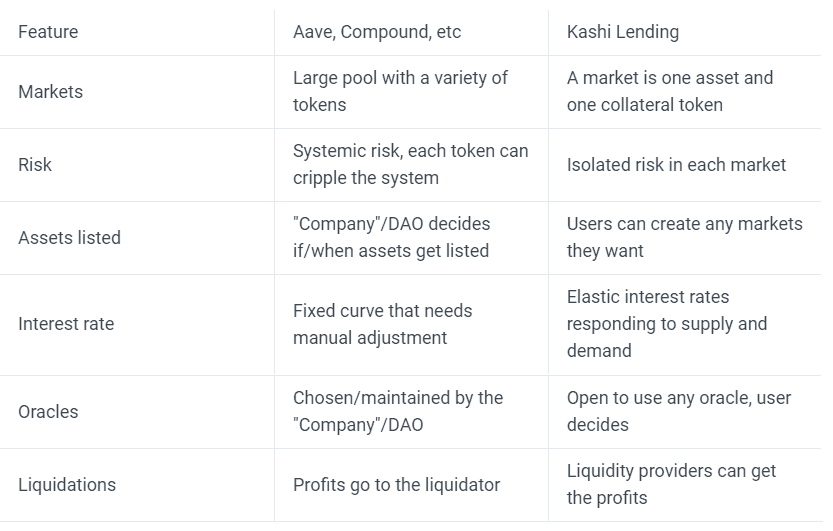
Kashi allows users to create ‘isolated’ lending markets. Users can borrow and lend into an already listed lending pair or create their own, where one token in the pair acts as the ‘asset’ and the other token in the pair acts as the ‘collateral’. This means the risk of assets within one lending market does not affect the risk of another lending market.
Previously, users who wanted to leverage an asset through direct lending and borrowing had to borrow on one platform, then lend on another, and so on. Because Kashi divides markets into pairs, lending and borrowing into the same market can be combined with a single click, allowing Kashi to automate leverage.
SushiSwap ‘Trident Framework’
Trident is the latest product from the SushiSwap team built on top of BentoBox. Trident is a framework for developing and deploying AMMs, but it is not an AMM in and of itself. So while the Trident code can be used to generate AMMs, there is no specific AMM at the heart of Trident. Instead, there is a framework that can be used to create any AMM that anyone would require.
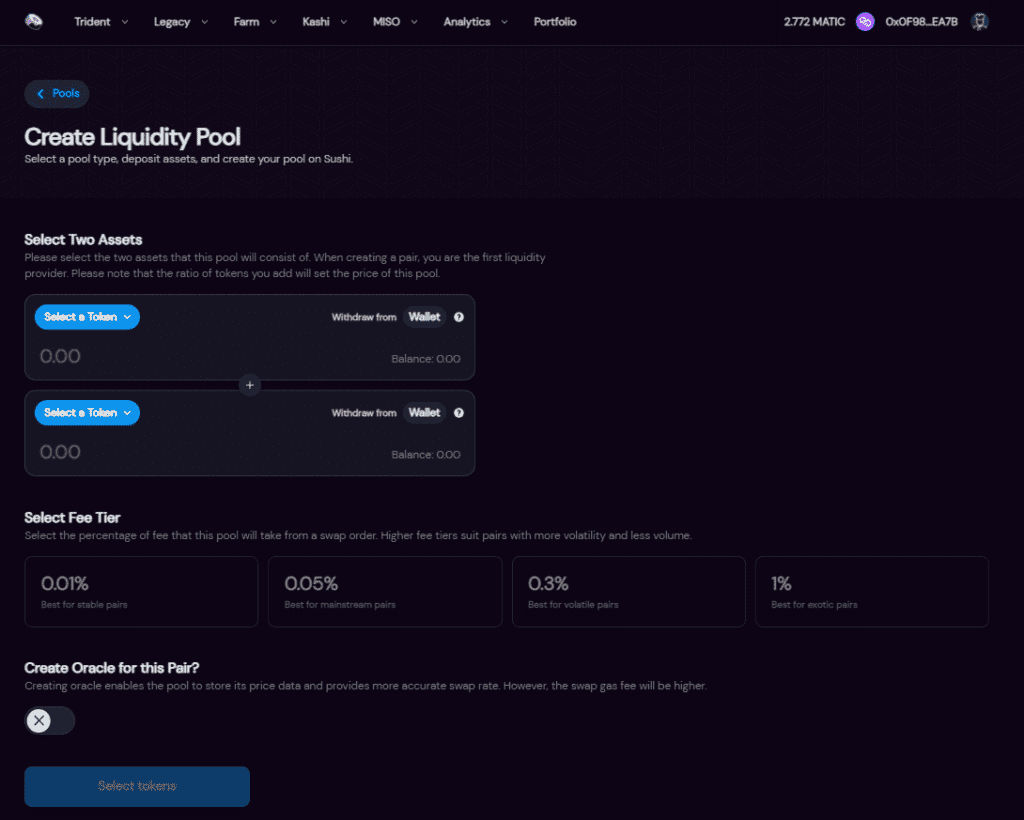
The concept behind this framework is to standardise AMM pool types, similar to how the ERC-20 token standard was needed for token types to become efficient. The Trident Framework will streamline the development process for creating and designing liquidity pools and AMMs.
Currently, the Trident Framework is in its beta on Polygon. Users can battle and security test the different elements before the team can clear them for porting them over to other chains.
Minimal Initial SushiSwap Offering (MISO)
MISO is a suite of open-source smart contracts created to ease the process of launching a new project on the SushiSwap exchange. The Minimal Initial SushiSwap Offering acts as an IDO-like launchpad for SushiSwap. It is a place for token creators and communities to launch new project tokens. Through MISO, SushiSwap aims to create a launchpad for technical and non-technical project founders, allowing communities and projects access to all the options they need for a secure and successful deployment to the SushiSwap exchange.
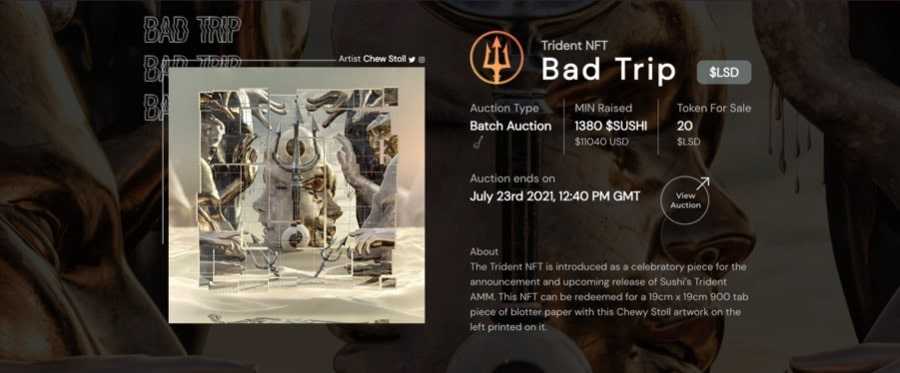
MISO creates a collection of out-of-the-box smart contracts for non-technical founders to choose over more traditional and code-oriented methods of token launching. At present, SushiSwap’s MISO launchpad offers a selection of NFT assets to investors through an auction system to celebrate the launch of new tokens on its platform. Thus, MISO is a clear indication of SushiSwap’s forward-thinking, cutting-edge architecture as it seeks to encapsulate both the hype-driven world of NFTs and the economic potential of IDOs into its ecosystem.
SushiSwap Governance
The SushiSwap team is currently developing a governance framework called Omakase DAO which will hand over control of the protocol to the community. Anyone with SLP tokens received from providing liquidity to the SUSHI-ETH pool or those with xSUSHI tokens (which also require SUSHI-ETH SLP tokens to get) will be able to vote for changes to SushiSwap.
Although the details are still being hammered out, it is anticipated that you will need to stake these tokens for a fixed amount of time to participate in voting.
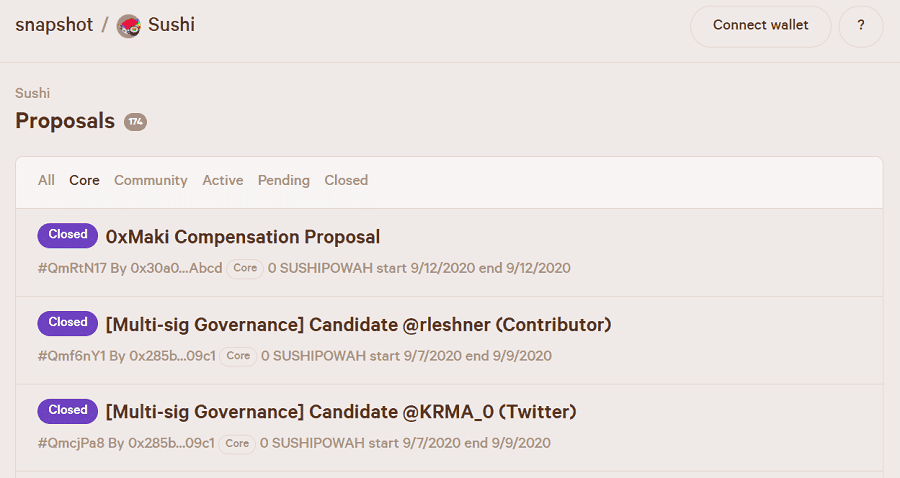
For the time being, SushiSwap Improvement Proposals (SIPs) can be tabled and voted on by anyone on the SushiSwap’s SushiPowah page on Snapshot. However, at this time, only proposals posted to the Snapshot voting system by the CORE can be considered binding if passed with a quorum. For those unfamiliar, Snapshot is a publicly viewable governance forum used by DeFi protocols such as Aave, Balancer, and Yearn.Finance.
‘SushiPowah’ is the voting metric of the governance forum. Each Sushi token held in the SUSHI-ETH pool is equal to 2 SUSHIPOWAH. In contrast, each Sushi held via the xSushi token equals 1 SUSHIPOWAH for or against the proposal. For a vote to pass and become binding, it must gain a quorum of at least 5 million SUSHIPOWAH.
The SUSHI Token
SUSHI is an ERC-20 token issued to liquidity providers (LPs) on the SushiSwap decentralised exchange (DEX). It is earned by providing liquidity to pools on SushiSwap or through farming in exchange for SLP tokens used to govern the protocol.

The token was designed to reward early protocol users by allowing them to continue earning a cut of SushiSwap’s fees even after they have stopped providing liquidity to SushiSwap’s pools. This can be done by staking SUSHI to earn more SUSHI on SushiSwap’s Sushi Bar.
SUSHI ICO
There was no ICO for SUSHI. The issuance of SUSHI began on Ethereum block number 10750000. As mentioned previously, 1000 SUSHI were being issued every Ethereum block (12 seconds) to those staking Uniswap LP tokens on SushiSwap’s initial protocol.
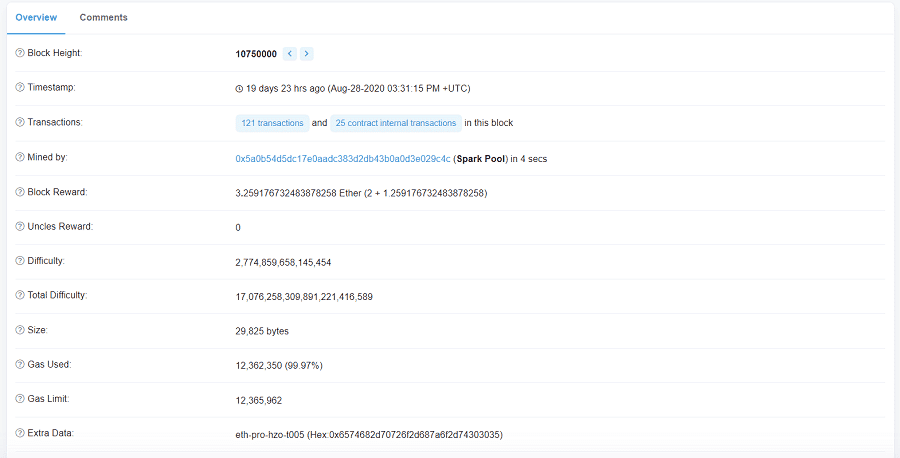
After ‘The Liquidity Migration’ occurred, SUSHI rewards dropped to 100 SUSHI per Ethereum block. This may be reduced by community vote. At the time of writing, the circulating supply of SUSHI equates to 241,099,876 SUSHI tokens, with a maximum supply of 250,000,000 SUSHI.
SUSHI Price Analysis
As you might have guessed, SUSHI entered the cryptocurrency market on August 28th 2020, with a near-zero value. However, by September 1st 2020, the price had skyrocketed from a few cents to over $12 as yield farmers rushed in to capitalize on the insane annual percentage yields offered by SushiSwap.
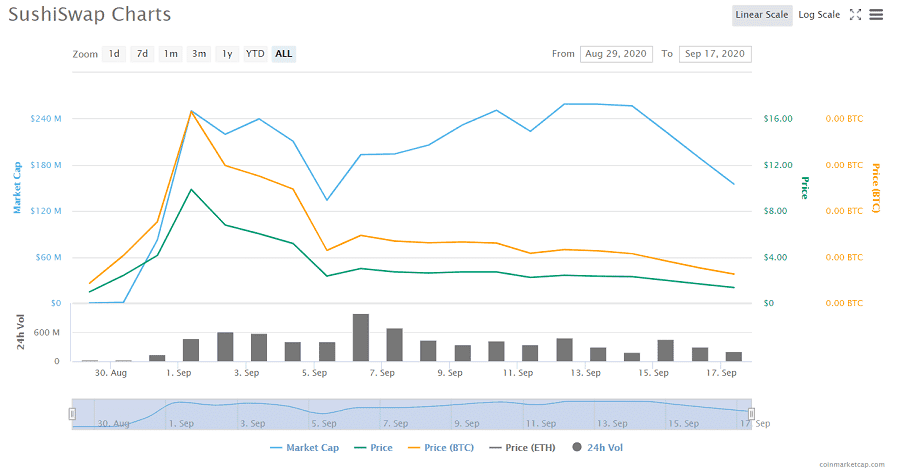
One day later, the price crashed by over 50% to under $6 and again dropped by more than 50% on September 5th 2020, to around $2.50 when SushiSwap’s co-founder Chef Nomi liquidated over 14m USD worth of SUSHI.

SUSHI is currently trading at approximately $3.27 and is down about 86.04% from its March 2021 ATH of $23.38. As one of the largest multichain DEXs in the DeFi space with a proven use case and over $1.51 billion in TVL, SushiSwap could potentially make a comeback to its previous $20+ ranges in the long-term outlook. Inherently, SushiSwap has so much going for it. It will most likely carry on growing alongside the rest of the Decentralised Finance ecosystem.
Where can I get SUSHI cryptocurrency?
SUSHI is almost just as easy to get as authentic sushi. Binance listed SUSHI on September 1 2020, which likely caused the incredible spike in price at the time. Since then, other reputable exchanges, including Huobi and OKX, have listed the token.
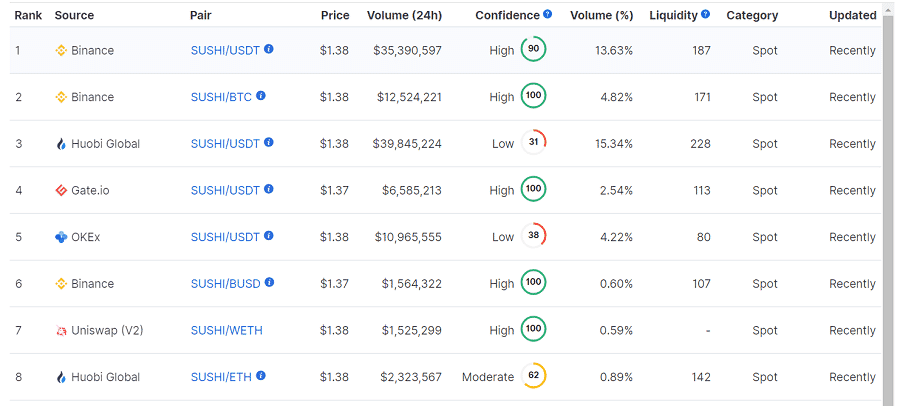
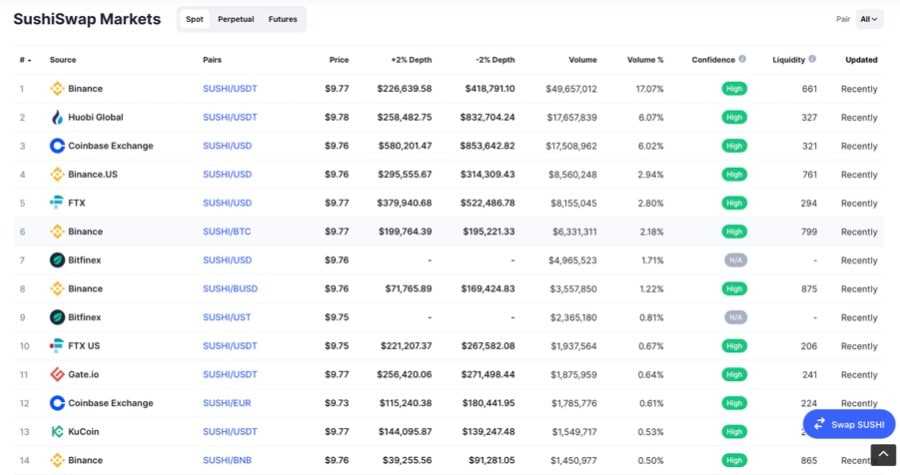
If you prefer decentralized exchanges, SUSHI is still available on Uniswap and can, of course, be purchased from the SushiSwap Exchange. Liquidity on all these exchanges is very high, and the 24-hour trading volume for SUSHI is nearly double its market cap. So you should have no issues getting your hands (or chopsticks) on this succulent cryptocurrency token.
SUSHI Cryptocurrency Wallets
Since SUSHI is an ERC-20 token, it can be stored in any cryptocurrency wallet that supports Ethereum-based assets. Where you should put your SUSHI depends on what you plan on doing with it.
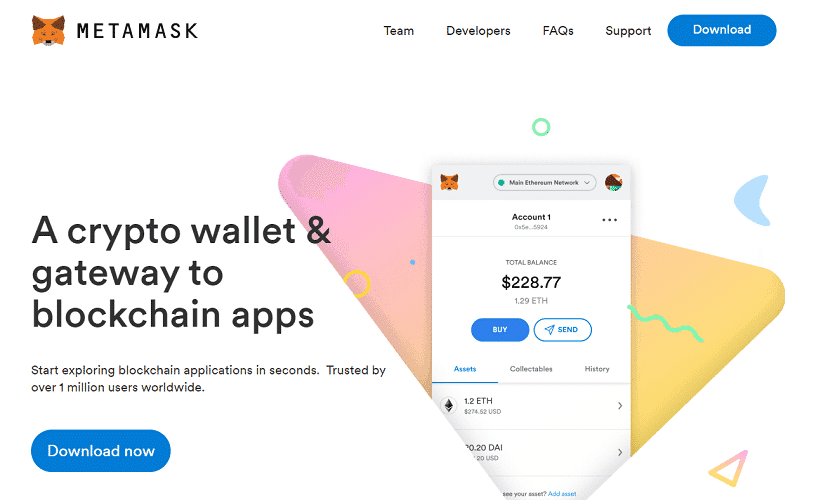
If you are interested in using SushiSwap to provide liquidity or participate in governance, your best bet would be a Web 3.0 wallet such as Metamask. On the other hand, if you plan on holding your SUSHI until the market is hungrier for it, a secure mobile wallet such as the Trezor wallet should do the trick!
SushiSwap Roadmap
SushiSwap has one goal and one goal only: to become the best DEX in cryptocurrency. This is quite a broad goal, and the new SushiSwap team does not currently detail any specific future milestones.
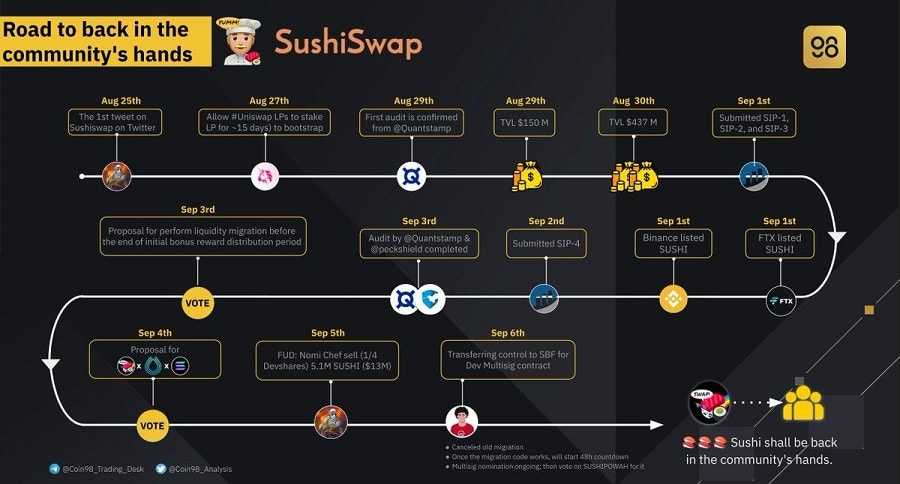
The closest document to a visual roadmap is SushiSwap’s Medium post dated September 12 2020. Since then, however, SushiSwap has released its 2021 incredibly ambitious roadmap, which includes its MISO upgrades, its aspiration to build on Layer-2, AMM 2.0 infrastructure, SushiBar Version 2 and Wrapped SLP tokens for greater DeFi utility.
Conclusion
Despite the seeming ridiculousness of the project and the chaos it has caused in its short history, SushiSwap has still managed to hold on to around 800 million of the initial 1.14 billion it drained from Uniswap. The DEX also maintains an average of 150 million USD of daily volume.
Despite experiencing a rather turbulent, bumpy journey at the beginning of its existence, SushiSwap has developed into one of the go-to DEX, yield farming and LP solutions in DeFi. It could potentially one day even come to steal the crown from Uniswap as the ultimate DEX platform.
But, it should also be noted that the relatively unprofessional naming and UI of many DeFi protocols, including SushiSwap, are perhaps even more distasteful to serious retail investors than seasoned yield farmers. In addition, controversies such as Chef Nomi’s exit scams really hurt the space at the end of the day.
That being said, SushiSwap seems to be serving up more delicious meals than ever under new management. The ambition and dedication of its core developers and community is admirable and may just be enough to carry the project forward well into the future.
Disclaimer: These are the writer’s opinions and should not be considered investment advice. Readers should do their own research.


